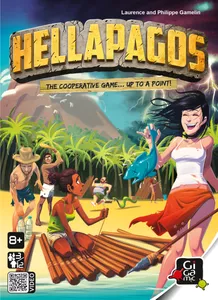Hellapagos is a self described “co-opetition” game, really engaging with design elements surrounding the player, focusing on mechanics that result in player-vs-player as well as a cooperative player-vs-environment or player-vs-game dynamics. The target audience for the game are people ages 8+, supporting anywhere between 3-12 players, with an ideal player size of 7-9. The game is played on tabletop, with cards, a board describing game state, as well as a bag of balls that simulate randomness. Our team’s concept (name TBD) is a card game and resource management game in which players manipulate the in-game economy, trying to reach various win conditions predesignated by player roles, which are all anonymous.
I was able to play Hellapagos with a group of nine players in class, and then again with a group of three players through Steam’s Tabletop Simulator and really enjoyed some of their concepts as it was, to me, a fresh take on combining a resource based game and its mechanics with that of a social game. Some of that influenced our game, which is why I wanted to perform a competitive analysis between the two.
The games are similar in various ways, but I think the most important ones are the emergent aesthetics that both are creating (or in our game’s case, that we hope to create). Those aesthetics are centered around cultivating “co-opetition”, an environment where players have conflicting interests as well as shared interests, resulting in a balancing act where players need to work together while managing their self-interests.
Hellapagos implements its “co-opetition” through the following mechanics. Player’s share two resources, food and water, all while having their cards that no one else can see. These cards can affect things like the resources, adding more when they’re running low, but can also contain cards that help them gain information about others’ cards as well as cards that affect other players’ turns or even cards that kill them (and thus, remove them from the game). To win the game, player’s must survive and construct n rafts, where n = number of living players, all while managing their food and water, each of which depletes every round by n. During a player’s turn, they can make one of four choices, which result in either additional food, additional water, progress on rafts, or collecting +1 card. The players all have a shared interest of managing the resources, but independent interests in gaining cards to bolster one’s own security in victory versus the group’s security as a whole.
Our game cultivates “co-opetition” through some similar, as well as some very different means. To summarize, it would be that our game uses anonymity as a core mechanic in creating cooperation while Hellapagos uses a shared resource, and our game uses independent goals tied with team-wide win conditions to create competition between two groups, while Hellapagos creates unique lose conditions that can only be caused or defended against through cards, which can only be gained through a “selfish” action.
In our game, everyone is either a “splurger” or a “hoarder”, with the former having the goal of losing all their coins while the latter hopes to gain 10 coins. Both roles have to avoid the opposing condition, otherwise they lose (i.e. if a “hoarder” has 0 coins they lose and vice-versa). Our game does not incorporate a shared resource but instead has each player starting with 5 coins, with the coins being moved around through players. Players have cards that allow them to move coins to them or away from them via the bank (the pile of coins in the center) or from other players. A few cards also allow players to move coins between other players. While both the “splurger” and “hoarder” have clear independent goals , the win condition for both teams is to have their team win, and the winning team is the one that has the most players that achieved their independent goal. Because of this, players have to work together until they are able to discern one another’s identities, and then they continue to work together, but against another group. Social deception also emerges as a dynamic due to information only being verifiable if one collects it themselves, making it easy to lie or be lied to about one’s role.
The social aesthetics that emerge from both games are similar, creating a loud, energetic, argumentative circle of people. A major difference in how the two games are “social” is due to a mechanic from Hellapagos that I have not yet mentioned: the voting. Anytime food or water is depleted, a player needs to die, and that player is chosen based on player voting. This explicitly creates social gameplay, as it is a direct mechanic of the game to converse and deliberate. In our game, deliberating and arguing are the main parts of what makes this game “social”, but unlike Hellapagos, that arises solely as a dynamic created through the mechanics of the game, since players can affect the game state much more effectively when making organized decisions. If players avoid all collaboration, then our game would reach some form of very slow progression or a stalemate, leading players to engage the game socially.




